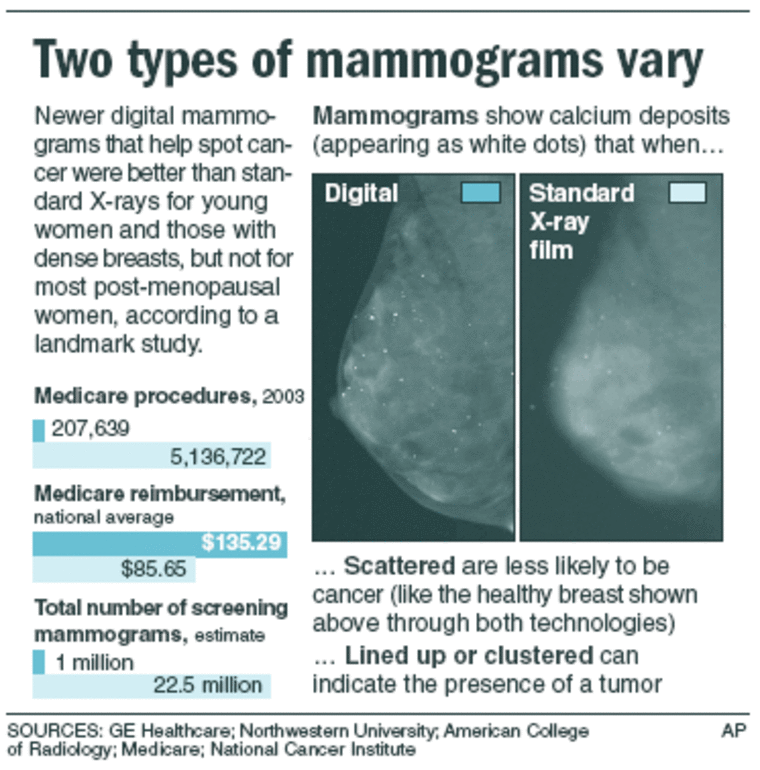Newer mammograms that allow doctors to use digital imaging to help spot cancer are better than standard X-rays for young women and those with dense breasts, but not for most post-menopausal women, a landmark study concludes.
Doctors say women who aren’t in one of the groups that benefited can skip the extra cost of the newer digital tests and have a standard mammogram.
However, they expect digital tests to become more common because of their many advantages, including that they can be stored on a computer and sent electronically whenever a woman moves or a new doctor needs to see them.
“Everything is going filmless. If there’s no disadvantage to digital mammography, I would presume over time it will replace film screening,” said Dr. Kathy Brandt, chief of breast imaging at the Mayo Clinic in Rochester, Minn., who had no role in the study.

The study involved 42,760 women in the United States and Canada and was done by the American College of Radiology Imaging Network. It was funded by the National Cancer Institute.
Results were to be reported Friday at a medical meeting. They also were released online by the New England Journal of Medicine and will appear in its Oct. 27 edition.
Mammograms cut the risk of dying of breast cancer by up to 35 percent among women 50 and older, but only by 15 to 20 percent among younger women, who tend to have dense breasts that standard film X-rays have trouble penetrating.
15 percent more accurate
Digital mammograms produce images on a computer screen, where they can be enhanced or magnified to reveal lurking signs of cancer. Doctors have hoped that this would improve mammography’s usefulness for younger women.
The study aimed to learn whether they are more accurate; that is, whether they correctly detected cancer and didn’t give too many “false alarms.”
Each participant received both types of mammograms. Results were reviewed independently by two radiologists, and biopsies settled whether suspicious findings were cancer. Follow-up exams were done a year later to see how many cancers had been missed the first time around.
A total of 335 breast cancers were found. Both types of mammograms missed about 30 percent of them.
Digital mammograms proved 15 percent more accurate than standard film X-rays among women under 50, in whom breast cancer is relatively uncommon. Among women with dense breasts and those not yet in menopause, digital mammograms were 11 percent and 15 percent better, respectively.
For all other women, “film is just as good,” said Dr. Etta Pisano, a radiologist at the University of North Carolina at Chapel Hill who led the study.
She said the results should help prioritize who gets the more expensive tests.
“We don’t have enough digital mammography for everyone to get it and some women won’t benefit from it anyway,” Pisano said.
The first digital machines came on the U.S. market in 2001, but they account for only 8 percent of mammography equipment today, largely because of cost. Medicare pays an average of $85.65 for a standard film mammogram and $135.29 for a digital one.
Robert Smith, director of screening at the American Cancer Society, said no woman should delay getting a mammogram if a digital one is not available. The society recommends annual mammograms starting at age 40; the federal government advises them every one to two years for women in their 40s and then annually starting at age 50.
As for the study results, “we’d always like a newer technology to do better in every way,” but improving mammograms for certain groups of women is still a gain, he said.
In the study, about two-thirds of women either had dense breasts, were under 50 or had not reached menopause. That led Dr. Daniel Sullivan, who heads cancer imaging at the cancer institute, to conclude “it may not be completely representative of the general population” because most mammograms are done on women over 50 who have fatty breasts.
The study was the largest ever done to compare mammography techniques. Earlier studies have found digital mammograms to be comparable in accuracy to film for women in general.